2024
SleepQuest
Designing for behavior change to help gamers build healthier sleep habits
2024
SleepQuest
Designing for behavior change to help gamers build healthier sleep habits
2024
SleepQuest
Designing for behavior change to help gamers build healthier sleep habits






Role
Product Designer
Team
3 Product Designers
Skills
Prototyping
UX/UI Design
Interaction Design
Behavior Change Design
Timeline
October - December 2024
2 Months
Role
Product Designer
Team
3 Product Designers
Skills
Prototyping
UX/UI Design
Interaction Design
Behavior Change Design
Timeline
October - December 2024
2 Months
Role
Product Designer
Team
3 Product Designers
Skills
Prototyping
UX/UI Design
Interaction Design
Behavior Change Design
Timeline
October - December 2024
2 Months
Summary
SleepQuest is a multi-device behavioral intervention designed to help gamers build healthier sleep habits without disrupting the enjoyment or social nature of gaming. Through research, strategy, and iterative design, I collaborated to design a solution that empowers users to make intentional choices around sleep, while keeping them in control of their experience.
Summary
SleepQuest is a multi-device behavioral intervention designed to help gamers build healthier sleep habits without disrupting the enjoyment or social nature of gaming. Through research, strategy, and iterative design, I collaborated to design a solution that empowers users to make intentional choices around sleep, while keeping them in control of their experience.
Summary
SleepQuest is a multi-device behavioral intervention designed to help gamers build healthier sleep habits without disrupting the enjoyment or social nature of gaming. Through research, strategy, and iterative design, I collaborated to design a solution that empowers users to make intentional choices around sleep, while keeping them in control of their experience.
Context
The Challenge: Designing for behavior change.
In SI 684: Designing Consumer Health Technologies, our team was challenged to select a specific population and design a digital solution to help adopt or reduce a health-related behavior.
Context
The Challenge: Designing for behavior change.
In SI 684: Designing Consumer Health Technologies, our team was challenged to select a specific population and design a digital solution to help adopt or reduce a health-related behavior.
Context
The Challenge: Designing for behavior change.
In SI 684: Designing Consumer Health Technologies, our team was challenged to select a specific population and design a digital solution to help adopt or reduce a health-related behavior.
Health Behavior
We focused on addressing chronic sleep deprivation, a widespread issue among young adults.
Health Behavior
We focused on addressing chronic sleep deprivation, a widespread issue among young adults.
Health Behavior
We focused on addressing chronic sleep deprivation, a widespread issue among young adults.
Target Population
Our solution targets individuals aged 18–29, a group especially vulnerable to irregular sleep patterns.
Target Population
Our solution targets individuals aged 18–29, a group especially vulnerable to irregular sleep patterns.
Tech Stack
Our solution targets individuals aged 18–29, a group especially vulnerable to irregular sleep patterns.
Behavioral Science
The design is grounded in behavioral science theories that support habit formation and long-term behavior change.
Behavioral Science
The design is grounded in behavioral science theories that support habit formation and long-term behavior change.
Behavioral Science
The design is grounded in behavioral science theories that support habit formation and long-term behavior change.
The Solution: Empowering gamers to build better sleep habits.
SleepQuest is a multi-device behavior-change solution that helps gamers improve sleep consistency without disrupting gameplay by integrating pre-set bedtimes, social support, and customizable in-game interventions.
The Solution: Empowering gamers to build better sleep habits.
SleepQuest is a multi-device behavior-change solution that helps gamers improve sleep consistency without disrupting gameplay by integrating pre-set bedtimes, social support, and customizable in-game interventions.
The Solution: Empowering gamers to build better sleep habits.
SleepQuest is a multi-device behavior-change solution that helps gamers improve sleep consistency without disrupting gameplay by integrating pre-set bedtimes, social support, and customizable in-game interventions.
Problem
Gamers struggle to balance late-night play with healthy sleep habits.
Sleep deprivation affects both physical and mental health and increases the risk of chronic conditions that cost the U.S. $4.5 trillion annually (CDC, 2024). Gaming, which is enjoyed by 78% of U.S. households (ESA, ITA), can unintentionally disrupt sleep when players stay up late fully immersed in the experience.
Problem
Gamers struggle to balance late-night play with healthy sleep habits.
Sleep deprivation affects both physical and mental health and increases the risk of chronic conditions that cost the U.S. $4.5 trillion annually (CDC, 2024). Gaming, which is enjoyed by 78% of U.S. households (ESA, ITA), can unintentionally disrupt sleep when players stay up late fully immersed in the experience.
Problem
Gamers struggle to balance late-night play with healthy sleep habits.
Sleep deprivation affects both physical and mental health and increases the risk of chronic conditions that cost the U.S. $4.5 trillion annually (CDC, 2024). Gaming, which is enjoyed by 78% of U.S. households (ESA, ITA), can unintentionally disrupt sleep when players stay up late fully immersed in the experience.
The Bedtime Battle
Gaming is a fun, social, and mentally stimulating activity driven by challenge and connection, but late-night sessions fueled by social pressure, fear of missing out, and immersion often cause gamers to stay up past their intended bedtime, leading to groggy, unrested mornings.
The Bedtime Battle
Gaming is a fun, social, and mentally stimulating activity driven by challenge and connection, but late-night sessions fueled by social pressure, fear of missing out, and immersion often cause gamers to stay up past their intended bedtime, leading to groggy, unrested mornings.
The Bedtime Battle
Gaming is a fun, social, and mentally stimulating activity driven by challenge and connection, but late-night sessions fueled by social pressure, fear of missing out, and immersion often cause gamers to stay up past their intended bedtime, leading to groggy, unrested mornings.

Starting a Game – The evening starts with a casual plan to play a game or two.

Starting a Game – The evening starts with a casual plan to play a game or two.

Starting a Game – The evening starts with a casual plan to play a game or two.

Social Pressure – Shared team goals create social pressure and make logging off feel like missing out.

Social Pressure – Shared team goals create social pressure and make logging off feel like missing out.

Social Pressure – Shared team goals create social pressure and make logging off feel like missing out.

Lack of Sleep – The cost of staying up late hits the next day with grogginess and low energy.

Lack of Sleep – The cost of staying up late hits the next day with grogginess and low energy.

Lack of Sleep – The cost of staying up late hits the next day with grogginess and low energy.
How Might We
How might we support gamers in creating and maintaining healthier sleep routines without sacrificing the fun, challenge, and connection of gaming?
How Might We
How might we support gamers in creating and maintaining healthier sleep routines without sacrificing the fun, challenge, and connection of gaming?
How Might We
How might we support gamers in creating and maintaining healthier sleep routines without sacrificing the fun, challenge, and connection of gaming?
User Research
Interviewing 4 gamers to understand how gameplay habits affect sleep behavior.
To better understand how gaming habits intersect with sleep behavior, we interviewed five gamers, including three who regularly play together in group sessions and two who primarily play solo. All participants acknowledged that their late-night gaming was negatively affecting their sleep and expressed a desire to change their habits. Here are highlights of what they shared:
User Research
Interviewing 4 gamers to understand how gameplay habits affect sleep behavior.
To better understand how gaming habits intersect with sleep behavior, we interviewed five gamers, including three who regularly play together in group sessions and two who primarily play solo. All participants acknowledged that their late-night gaming was negatively affecting their sleep and expressed a desire to change their habits. Here are highlights of what they shared:
User Research
Interviewing 4 gamers to understand how gameplay habits affect sleep behavior.
To better understand how gaming habits intersect with sleep behavior, we interviewed five gamers, including three who regularly play together in group sessions and two who primarily play solo. All participants acknowledged that their late-night gaming was negatively affecting their sleep and expressed a desire to change their habits. Here are highlights of what they shared:
Key Insights
Key InsightS & Opportunity Areas
Group Dynamics
"We play as a group, some of us are trying to get better about sleep, but others want to keep playing."
Group Dynamics
"We play as a group, some of us are trying to get better about sleep, but others want to keep playing."
Group Dynamics
"We play as a group, some of us are trying to get better about sleep, but others want to keep playing."
Social Pressure
"It's hard to get off when my friends are still playing. I feel like I'm letting them down."
Social Pressure
"It's hard to get off when my friends are still playing. I feel like I'm letting them down."
Social Pressure
"It's hard to get off when my friends are still playing. I feel like I'm letting them down."
Goal Oriented
"When I play with my friends, we usually only stop playing when we win."
Goal Oriented
"When I play with my friends, we usually only stop playing when we win."
Goal Oriented
"When I play with my friends, we usually only stop playing when we win."
Reminders Get Ignored
"I have the bedtime schedule set on my phone, but when I'm playing I'll just snooze or ignore it."
Reminders Get Ignored
"I have the bedtime schedule set on my phone, but when I'm playing I'll just snooze or ignore it."
Reminders Get Ignored
"I have the bedtime schedule set on my phone, but when I'm playing I'll just snooze or ignore it."
Turning user pain points into meaningful opportunity areas.
After interviews, we mapped key pain points around sleep and gameplay into clear opportunity areas to guide our ideation.
Turning user pain points into meaningful opportunity areas.
After interviews, we mapped key pain points around sleep and gameplay into clear opportunity areas to guide our ideation.
Turning user pain points into meaningful opportunity areas.
After interviews, we mapped key pain points around sleep and gameplay into clear opportunity areas to guide our ideation.
Opportunity Areas
opportunity Areas
Group Negotiations
Create groups that share similar sleep goals or tools to compromise on a shared bedtime.
Group Negotiations
Create groups that share similar sleep goals or tools to compromise on a shared bedtime.
Group Negotiations
Create groups that share similar sleep goals or tools to compromise on a shared bedtime.
Social Support
Provide social support and encouragement for logging off.
Social Support
Provide social support and encouragement for logging off.
Social Support
Provide social support and encouragement for logging off.
Sleep Goals
Allow users to set sleep goals, view progress, and rewards for achievements.
Sleep Goals
Allow users to set sleep goals, view progress, and rewards for achievements.
Sleep Goals
Allow users to set sleep goals, view progress, and rewards for achievements.
Integrated Reminders
Integrate reminders into the gameplay environment and haptic feedback (e.g., Smart watch).
Integrated Reminders
Integrate reminders into the gameplay environment and haptic feedback (e.g., Smart watch).
Integrated Reminders
Integrate reminders into the gameplay environment and haptic feedback (e.g., Smart watch).
Ideation
Exploring intervention ideas.
In a collaborative brainstorming session, we explored a range of intervention ideas focused on helping gamers build healthier sleep habits. Below is an overview of our main brainstorming results.
Ideation
Exploring intervention ideas.
In a collaborative brainstorming session, we explored a range of intervention ideas focused on helping gamers build healthier sleep habits. Below is an overview of our main brainstorming results.
Ideation
Exploring intervention ideas.
In a collaborative brainstorming session, we explored a range of intervention ideas focused on helping gamers build healthier sleep habits. Below is an overview of our main brainstorming results.



We landed on a multi-device socially-supported bedtime system rooted in commitment and progress.
We decided to focus on further exploring ways to provide gamers with social support for their bedtime goals, aiming to counter the social dynamics that keep them playing late. Initially, we explored group-based bedtime commitments, but found it unrealistic to expect all players to participate. This led us to shift our focus to external social support, where encouragement comes from people outside the gaming group.
We landed on a multi-device socially-supported bedtime system rooted in commitment and progress.
We decided to focus on further exploring ways to provide gamers with social support for their bedtime goals, aiming to counter the social dynamics that keep them playing late. Initially, we explored group-based bedtime commitments, but found it unrealistic to expect all players to participate. This led us to shift our focus to external social support, where encouragement comes from people outside the gaming group.
We landed on a multi-device socially-supported bedtime system rooted in commitment and progress.
We decided to focus on further exploring ways to provide gamers with social support for their bedtime goals, aiming to counter the social dynamics that keep them playing late. Initially, we explored group-based bedtime commitments, but found it unrealistic to expect all players to participate. This led us to shift our focus to external social support, where encouragement comes from people outside the gaming group.
Sketching out initial explorations.
With our direction focused on gaming groups, I created the following low-fidelity sketches to outline the core user flow and explore how the intervention would appear on both the gaming device and smartwatch.
Sketching out initial explorations.
With our direction focused on gaming groups, I created the following low-fidelity sketches to outline the core user flow and explore how the intervention would appear on both the gaming device and smartwatch.
Sketching out initial explorations.
With our direction focused on gaming groups, I created the following low-fidelity sketches to outline the core user flow and explore how the intervention would appear on both the gaming device and smartwatch.
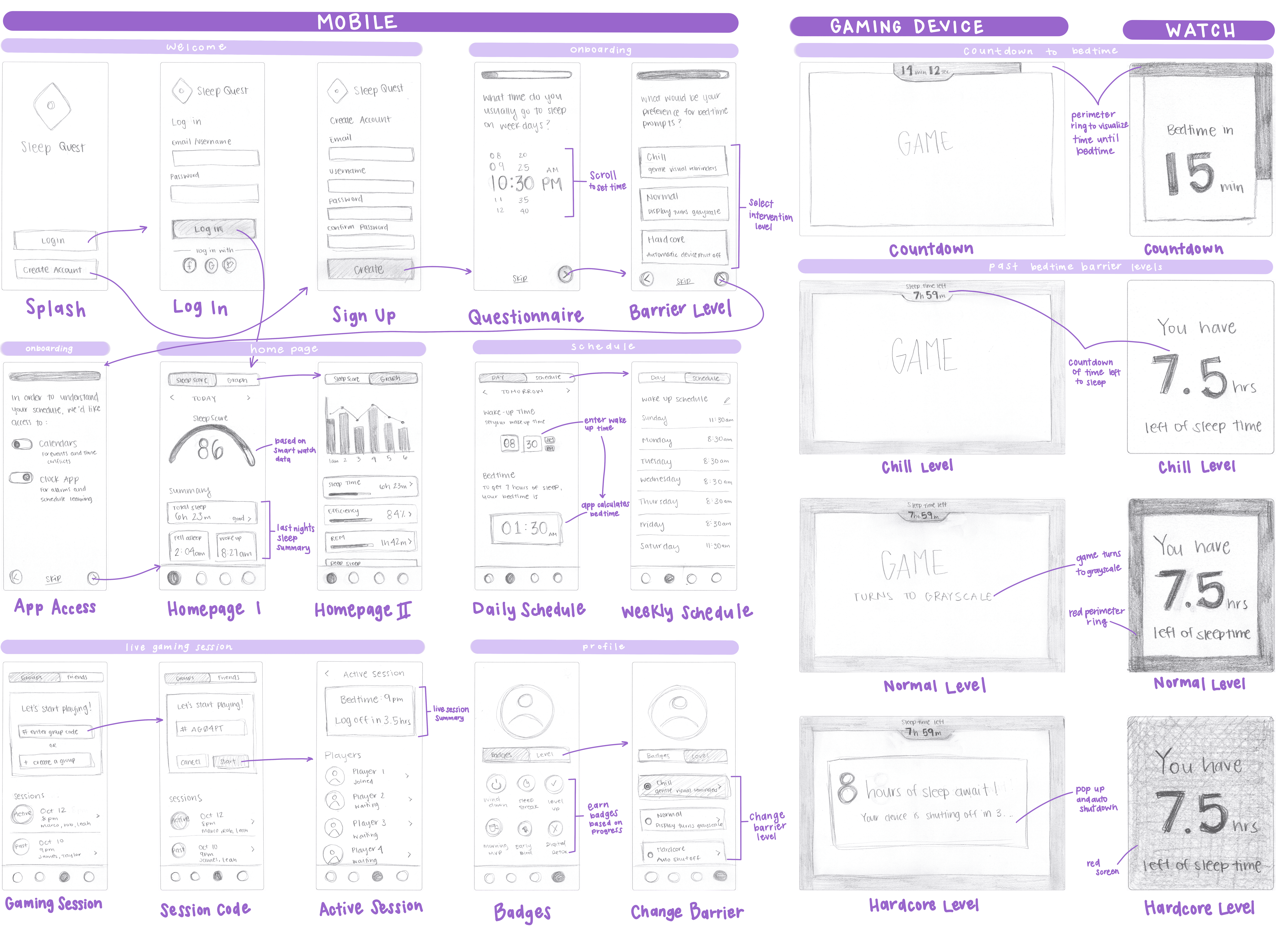


User Testing
Wizard of Oz Testing
To test our intervention, we created paper frames that fit over a computer screen to simulate the in-game experience, allowing us to observe user reactions and gather feedback.
User Testing
Wizard of Oz Testing
To test our intervention, we created paper frames that fit over a computer screen to simulate the in-game experience, allowing us to observe user reactions and gather feedback.
User Testing
Wizard of Oz Testing
To test our intervention, we created paper frames that fit over a computer screen to simulate the in-game experience, allowing us to observe user reactions and gather feedback.
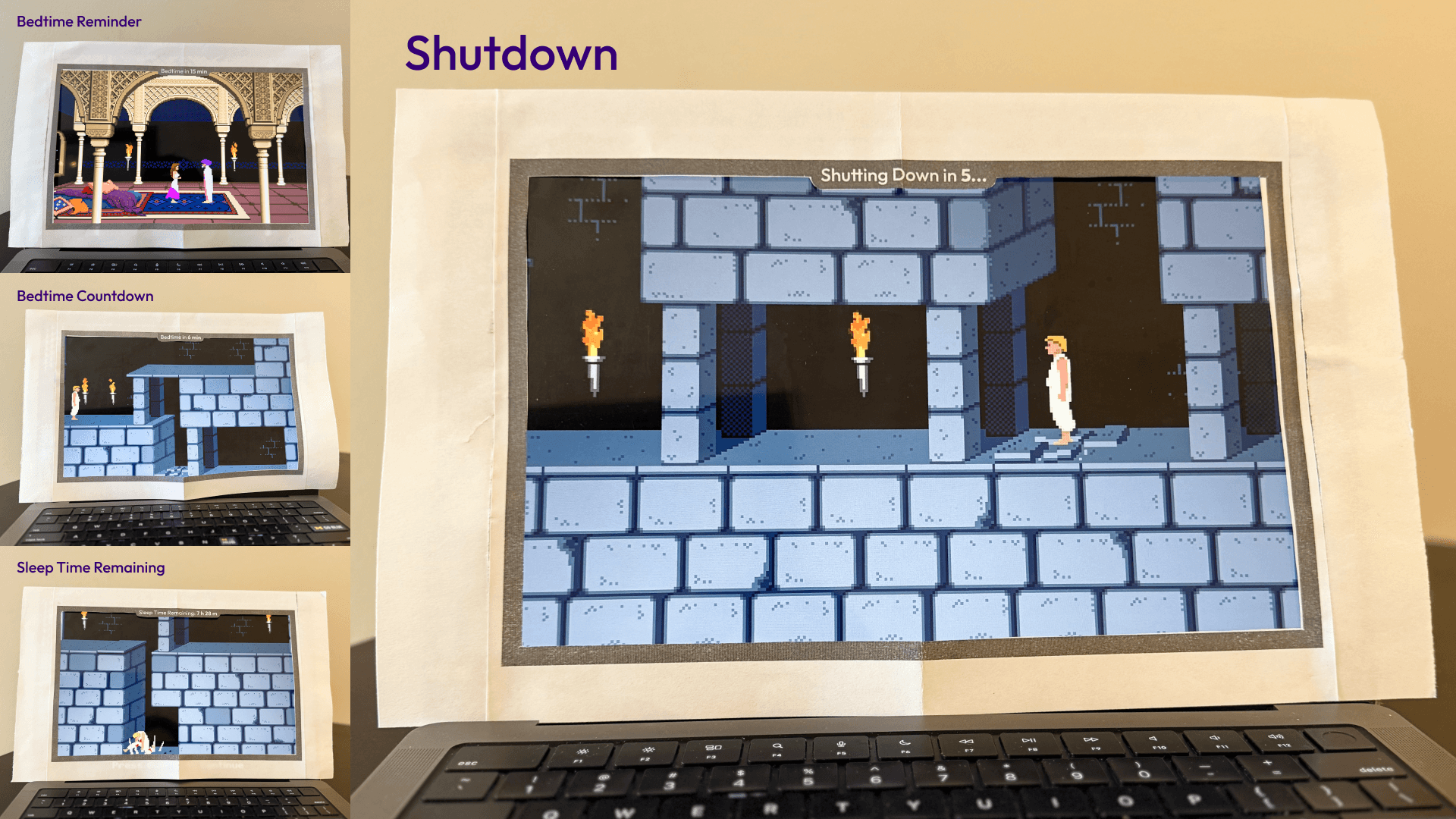


Iteration
Iterating based on user feedback.
After sketching preliminary low-fidelity designs, we created mid-fidelity wireframes to develop key user flows, build our vision for SleepQuest, and conduct user testing. During this process, I took ownership of the homepage, social support intervention, scheduling, and profile sections of the mobile app.
Iteration
Iterating based on user feedback.
After sketching preliminary low-fidelity designs, we created mid-fidelity wireframes to develop key user flows, build our vision for SleepQuest, and conduct user testing. During this process, I took ownership of the homepage, social support intervention, scheduling, and profile sections of the mobile app.
Iteration
Iterating based on user feedback.
After sketching preliminary low-fidelity designs, we created mid-fidelity wireframes to develop key user flows, build our vision for SleepQuest, and conduct user testing. During this process, I took ownership of the homepage, social support intervention, scheduling, and profile sections of the mobile app.
Homepage Iterations
The mobile app homepage serves as the central hub to review last night’s sleep, track progress, and start a live gaming session. Initially, we focused on detailed sleep metrics, but shifted to showing only overall hours of sleep since the detailed data was not aligned with SleepQuest's main focus.
Homepage Iterations
The mobile app homepage serves as the central hub to review last night’s sleep, track progress, and start a live gaming session. Initially, we focused on detailed sleep metrics, but shifted to showing only overall hours of sleep since the detailed data was not aligned with SleepQuest's main focus.
Homepage Iterations
The mobile app homepage serves as the central hub to review last night’s sleep, track progress, and start a live gaming session. Initially, we focused on detailed sleep metrics, but shifted to showing only overall hours of sleep since the detailed data was not aligned with SleepQuest's main focus.
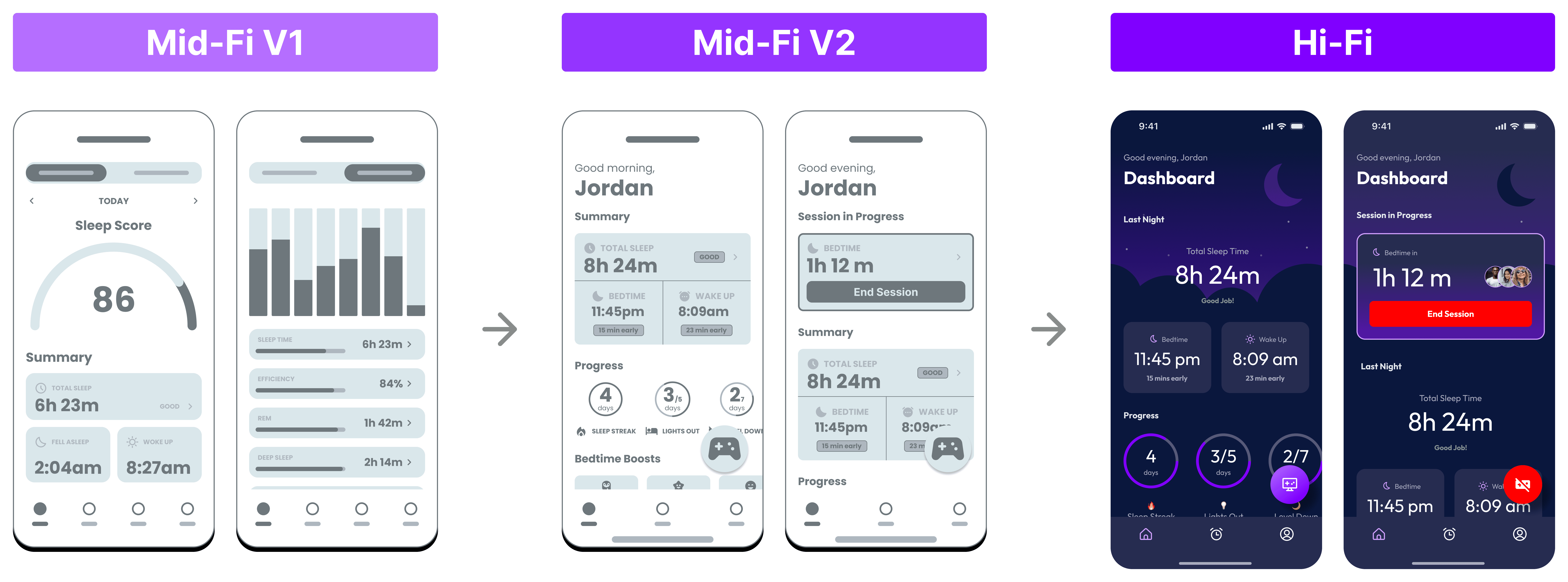


V1: Data-Heavy Dashboard
Sleep info encourages self-reflection on sleep habits
Overly complex layout with multiple views
Overemphasized sleep data, distracting from core purpose
V1: Data-Heavy Dashboard
Sleep info encourages self-reflection on sleep habits
Overly complex layout with multiple views
Overemphasized sleep data, distracting from core purpose
V1: Data-Heavy Dashboard
Sleep info encourages self-reflection on sleep habits
Overly complex layout with multiple views
Overemphasized sleep data, distracting from core purpose
V2: Simplified Summary
Centers progress around sleep-gaming balance
Live session button emphasizes primary action
Visually cluttered with dense content is overwhelming
V2: Simplified Summary
Centers progress around sleep-gaming balance
Live session button emphasizes primary action
Visually cluttered with dense content is overwhelming
V2: Simplified Summary
Centers progress around sleep-gaming balance
Live session button emphasizes primary action
Visually cluttered with dense content is overwhelming
V3: Refined Hi-Fi
Improved spacing makes content more digestible
Enhanced visual hierarchy guides user attention
Enlarged touch targets to reduce mis-clicks
V3: Refined Hi-Fi
Improved spacing makes content more digestible
Enhanced visual hierarchy guides user attention
Enlarged touch targets to reduce mis-clicks
V3: Refined Hi-Fi
Improved spacing makes content more digestible
Enhanced visual hierarchy guides user attention
Enlarged touch targets to reduce mis-clicks
Social Support Iterations
The social support feature was initially designed to help gamer groups support each other and agree on a group bedtime. However, after user testing, we found it was unrealistic to expect all group members to have the app and be motivated to improve their sleep. Additionally, gamers within the same group often have conflicting interests, as they want to keep playing rather than encourage friends to go to bed. Because of this, we shifted our focus to external social support, allowing users to receive encouragement from contacts outside their gaming group.
Social Support Iterations
The social support feature was initially designed to help gamer groups support each other and agree on a group bedtime. However, after user testing, we found it was unrealistic to expect all group members to have the app and be motivated to improve their sleep. Additionally, gamers within the same group often have conflicting interests, as they want to keep playing rather than encourage friends to go to bed. Because of this, we shifted our focus to external social support, allowing users to receive encouragement from contacts outside their gaming group.
Social Support Iterations
The social support feature was initially designed to help gamer groups support each other and agree on a group bedtime. However, after user testing, we found it was unrealistic to expect all group members to have the app and be motivated to improve their sleep. Additionally, gamers within the same group often have conflicting interests, as they want to keep playing rather than encourage friends to go to bed. Because of this, we shifted our focus to external social support, allowing users to receive encouragement from contacts outside their gaming group.
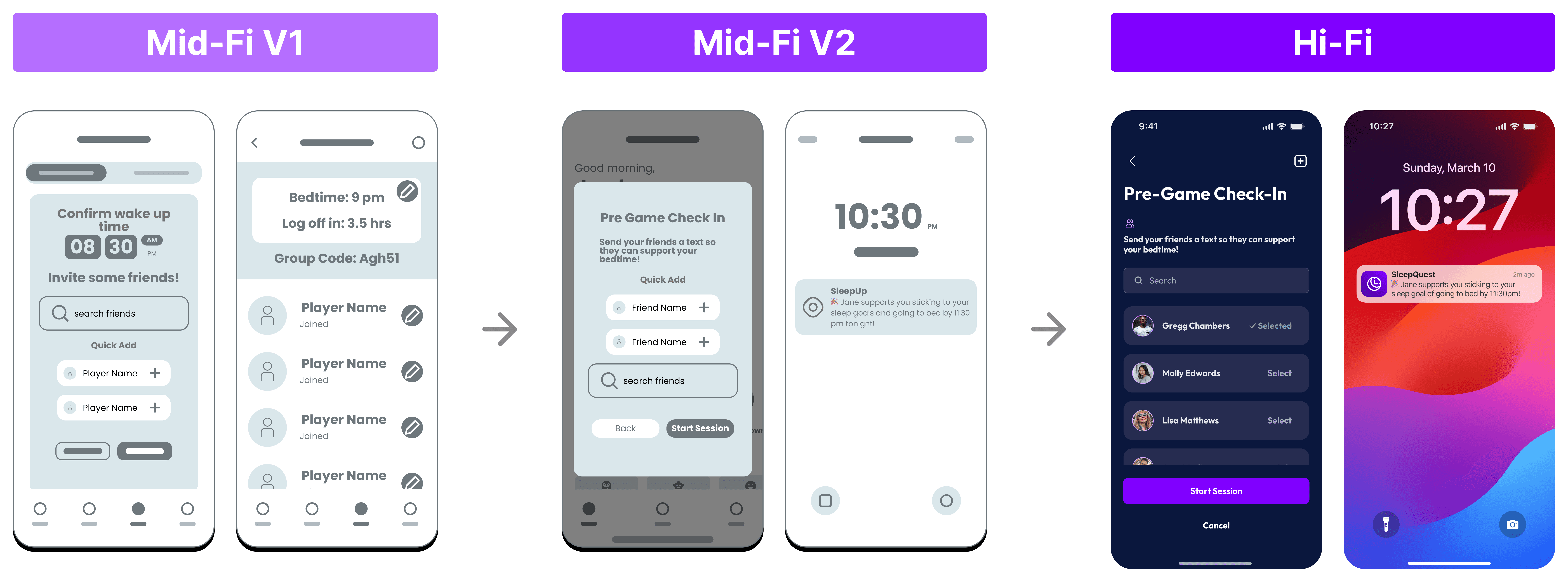


V1: Group Bedtime Focus
Encourages team-based accountability
Doesn't account for partial participation or opt-outs
Conflicting goals reduce peer support effectiveness
V1: Group Bedtime Focus
Encourages team-based accountability
Doesn't account for partial participation or opt-outs
Conflicting goals reduce peer support effectiveness
V1: Group Bedtime Focus
Encourages team-based accountability
Doesn't account for partial participation or opt-outs
Conflicting goals reduce peer support effectiveness
V2: Flexible Groups
Allows users to choose their supporters for more flexibility
Eliminates dependency on full group participation
Lacks structure for users who don't know who to invite
V2: Flexible Groups
Allows users to choose their supporters for more flexibility
Eliminates dependency on full group participation
Lacks structure for users who don't know who to invite
V2: Flexible Groups
Allows users to choose their supporters for more flexibility
Eliminates dependency on full group participation
Lacks structure for users who don't know who to invite
V3: External Social Support
Simplifies repeat interactions with quick-add friends
Consistent feedback loop between user and friends
Works well for both solo and group gamers
V3: External Social Support
Simplifies repeat interactions with quick-add friends
Consistent feedback loop between user and friends
Works well for both solo and group gamers
V3: External Social Support
Simplifies repeat interactions with quick-add friends
Consistent feedback loop between user and friends
Works well for both solo and group gamers
Bedtime Countdown Iterations
When the user approaches, a countdown appears as a perimeter ring around the screen of their gaming device. Initially, it displayed only the countdown time, but we updated it to include text explaining the purpose of the countdown. We also added a notification that appears briefly when the user receives support from external contacts who encourage their bedtime.
Bedtime Countdown Iterations
When the user approaches, a countdown appears as a perimeter ring around the screen of their gaming device. Initially, it displayed only the countdown time, but we updated it to include text explaining the purpose of the countdown. We also added a notification that appears briefly when the user receives support from external contacts who encourage their bedtime.
Bedtime Countdown Iterations
When the user approaches, a countdown appears as a perimeter ring around the screen of their gaming device. Initially, it displayed only the countdown time, but we updated it to include text explaining the purpose of the countdown. We also added a notification that appears briefly when the user receives support from external contacts who encourage their bedtime.



V1: Countdown Ring
Minimal visual distraction preserves game immersion
Lacks context, making the countdown easy to ignore
Users may tune it out as visual noise over time
V1: Countdown Ring
Minimal visual distraction preserves game immersion
Lacks context, making the countdown easy to ignore
Users may tune it out as visual noise over time
V1: Countdown Ring
Minimal visual distraction preserves game immersion
Lacks context, making the countdown easy to ignore
Users may tune it out as visual noise over time
V2: Contextual Ring
Added clarity reminds users what countdown represents
Increases perceived relevance of the intervention
Disconnected from social support intervention
V2: Contextual Ring
Added clarity reminds users what countdown represents
Increases perceived relevance of the intervention
Disconnected from social support intervention
V2: Contextual Ring
Added clarity reminds users what countdown represents
Increases perceived relevance of the intervention
Disconnected from social support intervention
V3: Encouragement Nudge
Minimizes disruption by avoiding center-screen
Adds a timely nudge without needing user interaction
Encouragement feels supportive, not controling
V3: Encouragement Nudge
Minimizes disruption by avoiding center-screen
Adds a timely nudge without needing user interaction
Encouragement feels supportive, not controling
V3: Encouragement Nudge
Minimizes disruption by avoiding center-screen
Adds a timely nudge without needing user interaction
Encouragement feels supportive, not controling
"Hardcore" Intervention Iterations
If the user plays past their set bedtime, they receive an intervention barrier at one of three levels: Chill, Normal, or Hardcore. These levels are chosen during onboarding and can be changed later. The original Hardcore level shut down the gaming device automatically, but users found this too aggressive and frustrating during gameplay. We revised it so the screen gradually dims, allowing users to snooze the intervention for more control while still encouraging their bedtime.
"Hardcore" Intervention Iterations
If the user plays past their set bedtime, they receive an intervention barrier at one of three levels: Chill, Normal, or Hardcore. These levels are chosen during onboarding and can be changed later. The original Hardcore level shut down the gaming device automatically, but users found this too aggressive and frustrating during gameplay. We revised it so the screen gradually dims, allowing users to snooze the intervention for more control while still encouraging their bedtime.
"Hardcore" Intervention Iterations
If the user plays past their set bedtime, they receive an intervention barrier at one of three levels: Chill, Normal, or Hardcore. These levels are chosen during onboarding and can be changed later. The original Hardcore level shut down the gaming device automatically, but users found this too aggressive and frustrating during gameplay. We revised it so the screen gradually dims, allowing users to snooze the intervention for more control while still encouraging their bedtime.



V1: Instant Shutdown
Maximally effective at enforcing pre-set bedtime
Highly disruptive, especially if user is mid-game
Frustrating loss of control, leading to abandonment
V1: Instant Shutdown
Maximally effective at enforcing pre-set bedtime
Highly disruptive, especially if user is mid-game
Frustrating loss of control, leading to abandonment
V1: Instant Shutdown
Maximally effective at enforcing pre-set bedtime
Highly disruptive, especially if user is mid-game
Frustrating loss of control, leading to abandonment
V2: Screen Dim + Snooze
Gradual and less intrusive than an immediate shutdown
Snooze interaction adds a layer of reflection
Weakens barrier and may lead to habitual dismissals
V2: Screen Dim + Snooze
Gradual and less intrusive than an immediate shutdown
Snooze interaction adds a layer of reflection
Weakens barrier and may lead to habitual dismissals
V2: Screen Dim + Snooze
Gradual and less intrusive than an immediate shutdown
Snooze interaction adds a layer of reflection
Weakens barrier and may lead to habitual dismissals
V3: Limited Snooze
Clear feedback loop frames consequences of snoozing
Strengthens perceived value of snooze feature
Reinforces defined agency within defined boundaries
V3: Limited Snooze
Clear feedback loop frames consequences of snoozing
Strengthens perceived value of snooze feature
Reinforces defined agency within defined boundaries
V3: Limited Snooze
Clear feedback loop frames consequences of snoozing
Strengthens perceived value of snooze feature
Reinforces defined agency within defined boundaries
Final Designs
A sleep-friendly companion for gamers.
SleepQuest is a multi-platform solution that helps gamers set bedtime commitments, track their sleep progress, and activate in-game interventions that support healthier sleep habits without disrupting gameplay.
Final Designs
A sleep-friendly companion for gamers.
SleepQuest is a multi-platform solution that helps gamers set bedtime commitments, track their sleep progress, and activate in-game interventions that support healthier sleep habits without disrupting gameplay.
Final Designs
A sleep-friendly companion for gamers.
SleepQuest is a multi-platform solution that helps gamers set bedtime commitments, track their sleep progress, and activate in-game interventions that support healthier sleep habits without disrupting gameplay.
Multi-Device Solution
The intervention works seamlessly across mobile, smartwatch, and gaming screen to support users throughout their routine. By integrating with tools gamers already use, it delivers timely, context-aware cues without disrupting gameplay, creating a cohesive experience across planning and play.
Multi-Device Solution
The intervention works seamlessly across mobile, smartwatch, and gaming screen to support users throughout their routine. By integrating with tools gamers already use, it delivers timely, context-aware cues without disrupting gameplay, creating a cohesive experience across planning and play.
Multi-Device Solution
The intervention works seamlessly across mobile, smartwatch, and gaming screen to support users throughout their routine. By integrating with tools gamers already use, it delivers timely, context-aware cues without disrupting gameplay, creating a cohesive experience across planning and play.



Gameplay Barriers
SleepQuest activates a visual screen barrier on the console or laptop when bedtime is near or has passed, based on a support level selected by the user. This barrier clearly displays how much sleep time remains and escalates based on the chosen mode:
Chill — Shows a red perimeter ring with a countdown of remaining sleep time.
Normal — Includes Chill mode and adds a grayscale filter to reduce visual stimulation.
Hardcore — Builds on Normal by gradually dimming the screen until it shuts off, encouraging the user to log off, enabling 3 snoozes.
Gameplay Barriers
SleepQuest activates a visual screen barrier on the console or laptop when bedtime is near or has passed, based on a support level selected by the user. This barrier clearly displays how much sleep time remains and escalates based on the chosen mode:
Chill — Shows a red perimeter ring with a countdown of remaining sleep time.
Normal — Includes Chill mode and adds a grayscale filter to reduce visual stimulation.
Hardcore — Builds on Normal by gradually dimming the screen until it shuts off, encouraging the user to log off, enabling 3 snoozes.
Gameplay Barriers
SleepQuest activates a visual screen barrier on the console or laptop when bedtime is near or has passed, based on a support level selected by the user. This barrier clearly displays how much sleep time remains and escalates based on the chosen mode:
Chill — Shows a red perimeter ring with a countdown of remaining sleep time.
Normal — Includes Chill mode and adds a grayscale filter to reduce visual stimulation.
Hardcore — Builds on Normal by gradually dimming the screen until it shuts off, encouraging the user to log off, enabling 3 snoozes.



Mobile App
The mobile app serves as the central hub for the SleepQuest experience, guiding users through onboarding, helping them track progress, and enabling them to start gaming sessions with personalized bedtime support. Designed to be intuitive and motivating, the app keeps users engaged with features that align their sleep goals with their gaming routine.
Mobile App
The mobile app serves as the central hub for the SleepQuest experience, guiding users through onboarding, helping them track progress, and enabling them to start gaming sessions with personalized bedtime support. Designed to be intuitive and motivating, the app keeps users engaged with features that align their sleep goals with their gaming routine.
Mobile App
The mobile app serves as the central hub for the SleepQuest experience, guiding users through onboarding, helping them track progress, and enabling them to start gaming sessions with personalized bedtime support. Designed to be intuitive and motivating, the app keeps users engaged with features that align their sleep goals with their gaming routine.
Onboarding
The onboarding flow quickly orients users and personalizes their experience through a brief questionnaire about sleep habits and goals. Users then sync devices for seamless tracking and choose a sleep strategy by selecting from three levels of in-game support.
Onboarding
The onboarding flow quickly orients users and personalizes their experience through a brief questionnaire about sleep habits and goals. Users then sync devices for seamless tracking and choose a sleep strategy by selecting from three levels of in-game support.
Onboarding
The onboarding flow quickly orients users and personalizes their experience through a brief questionnaire about sleep habits and goals. Users then sync devices for seamless tracking and choose a sleep strategy by selecting from three levels of in-game support.






Gaming Session
The gaming session flow makes it easy for users to stay on track while playing. A floating action button lets users quickly start a session, followed by a pre-game check-in where they confirm their wake-up time, review their sleep goal, and choose whether to enable social support by notifying friends.
Gaming Session
The gaming session flow makes it easy for users to stay on track while playing. A floating action button lets users quickly start a session, followed by a pre-game check-in where they confirm their wake-up time, review their sleep goal, and choose whether to enable social support by notifying friends.
Gaming Session
The gaming session flow makes it easy for users to stay on track while playing. A floating action button lets users quickly start a session, followed by a pre-game check-in where they confirm their wake-up time, review their sleep goal, and choose whether to enable social support by notifying friends.
Schedule
The schedule tab provides a clear, flexible overview of users’ sleep plans. A daily view shows the recommended bedtime based on the next morning’s wake-up time, while the weekly view allows users to customize their sleep schedule around changing routines.
Schedule
The schedule tab provides a clear, flexible overview of users’ sleep plans. A daily view shows the recommended bedtime based on the next morning’s wake-up time, while the weekly view allows users to customize their sleep schedule around changing routines.
Schedule
The schedule tab provides a clear, flexible overview of users’ sleep plans. A daily view shows the recommended bedtime based on the next morning’s wake-up time, while the weekly view allows users to customize their sleep schedule around changing routines.






Personalized Profile
The profile tab offers a personalized overview where users can track earned badges for sleep goals and adjust settings like their in-game barrier level to match their current habits.
Personalized Profile
The profile tab offers a personalized overview where users can track earned badges for sleep goals and adjust settings like their in-game barrier level to match their current habits.
Personalized Profile
The profile tab offers a personalized overview where users can track earned badges for sleep goals and adjust settings like their in-game barrier level to match their current habits.
Social Support
The social support system enhances users’ ability to initiate and sustain behavior change by enabling them to receive encouragement from their network. Users can add contacts and invite friends to support their bedtime goals during a gaming session.
As bedtime approaches, friends receive a text message prompt and can respond with emoji reactions. These responses trigger push notifications for the user, providing simple and timely reinforcement that helps them follow through on their sleep commitments.
Social Support
The social support system enhances users’ ability to initiate and sustain behavior change by enabling them to receive encouragement from their network. Users can add contacts and invite friends to support their bedtime goals during a gaming session.
As bedtime approaches, friends receive a text message prompt and can respond with emoji reactions. These responses trigger push notifications for the user, providing simple and timely reinforcement that helps them follow through on their sleep commitments.
Social Support
The social support system enhances users’ ability to initiate and sustain behavior change by enabling them to receive encouragement from their network. Users can add contacts and invite friends to support their bedtime goals during a gaming session.
As bedtime approaches, friends receive a text message prompt and can respond with emoji reactions. These responses trigger push notifications for the user, providing simple and timely reinforcement that helps them follow through on their sleep commitments.
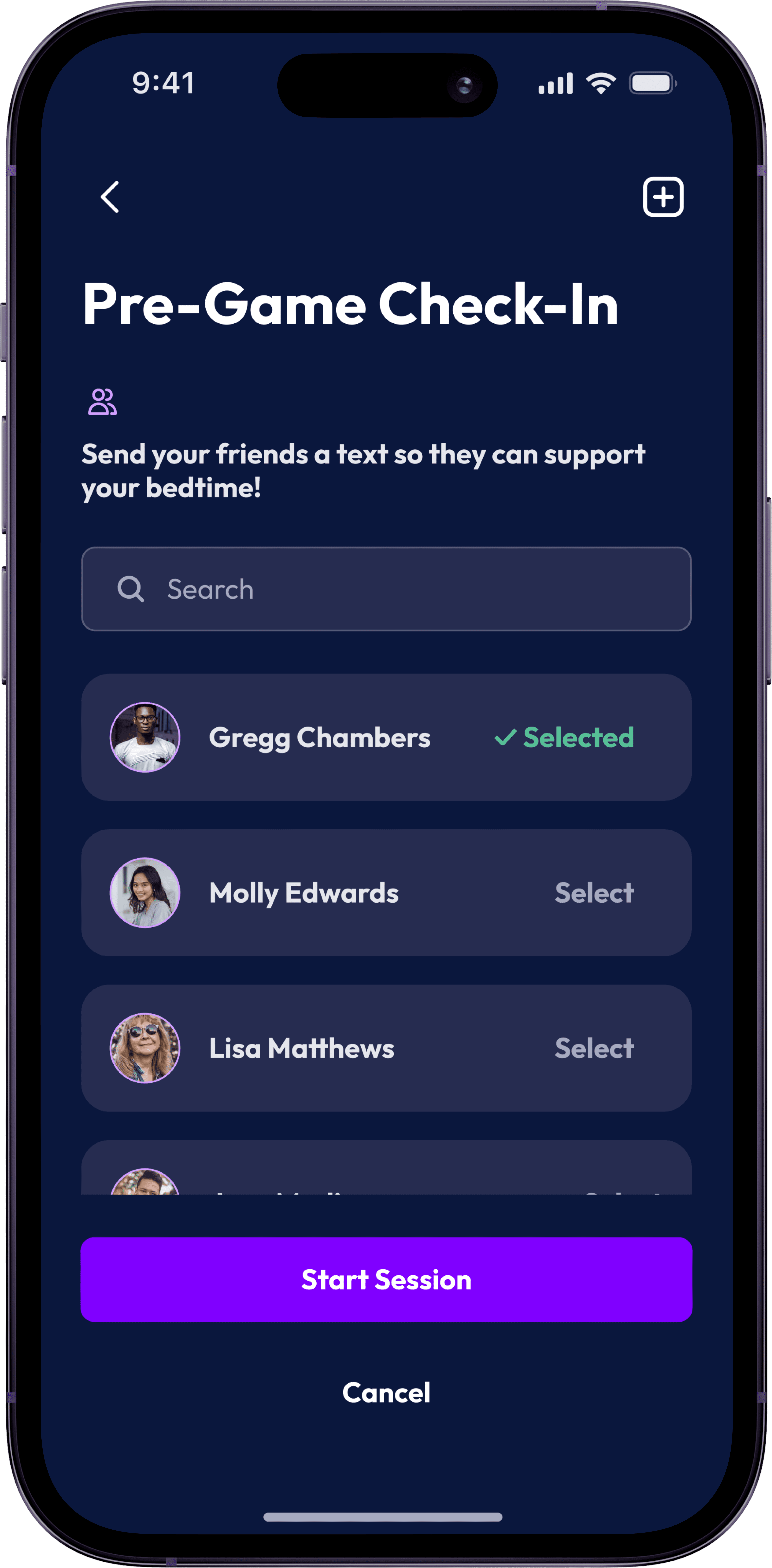


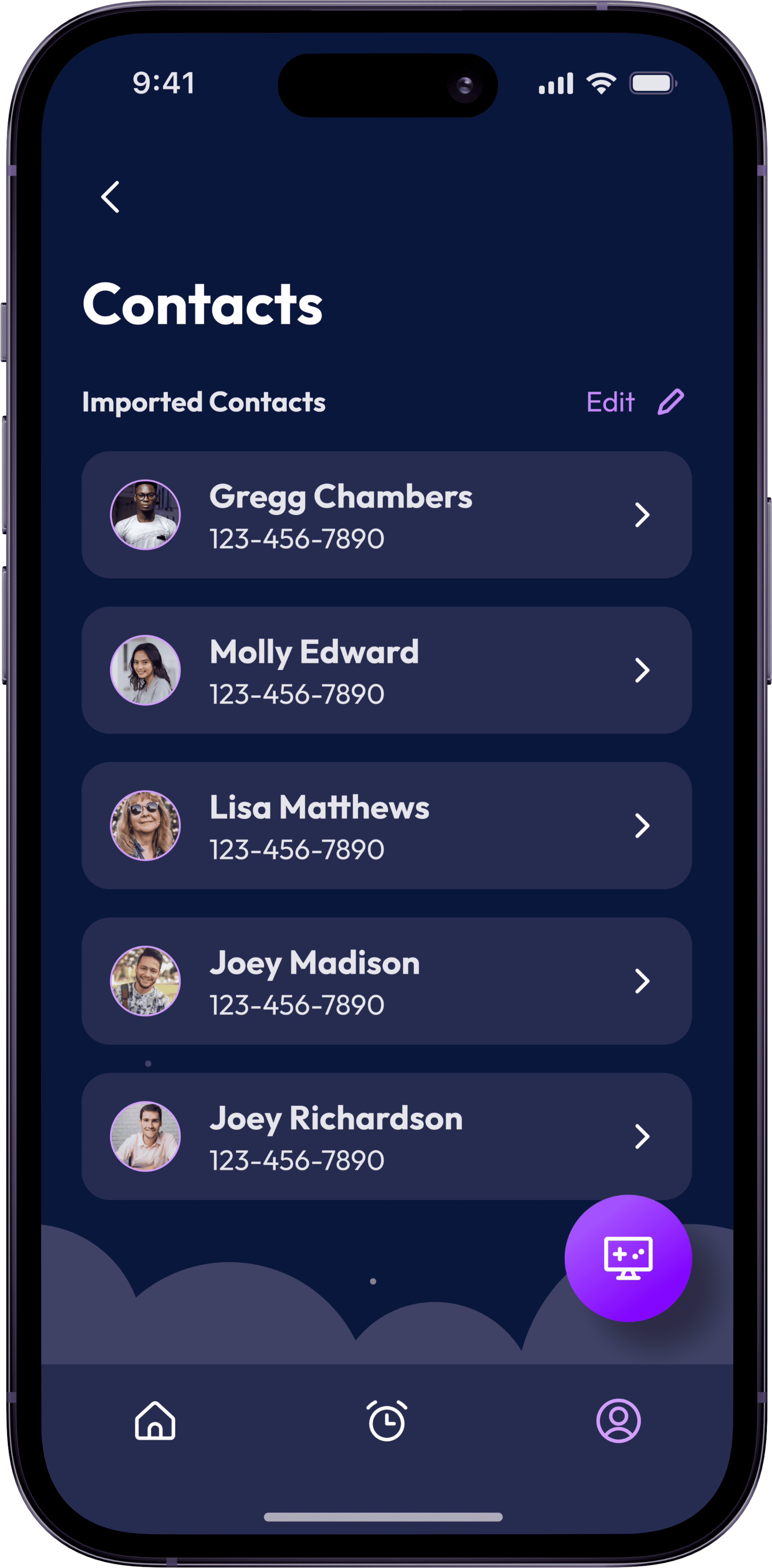


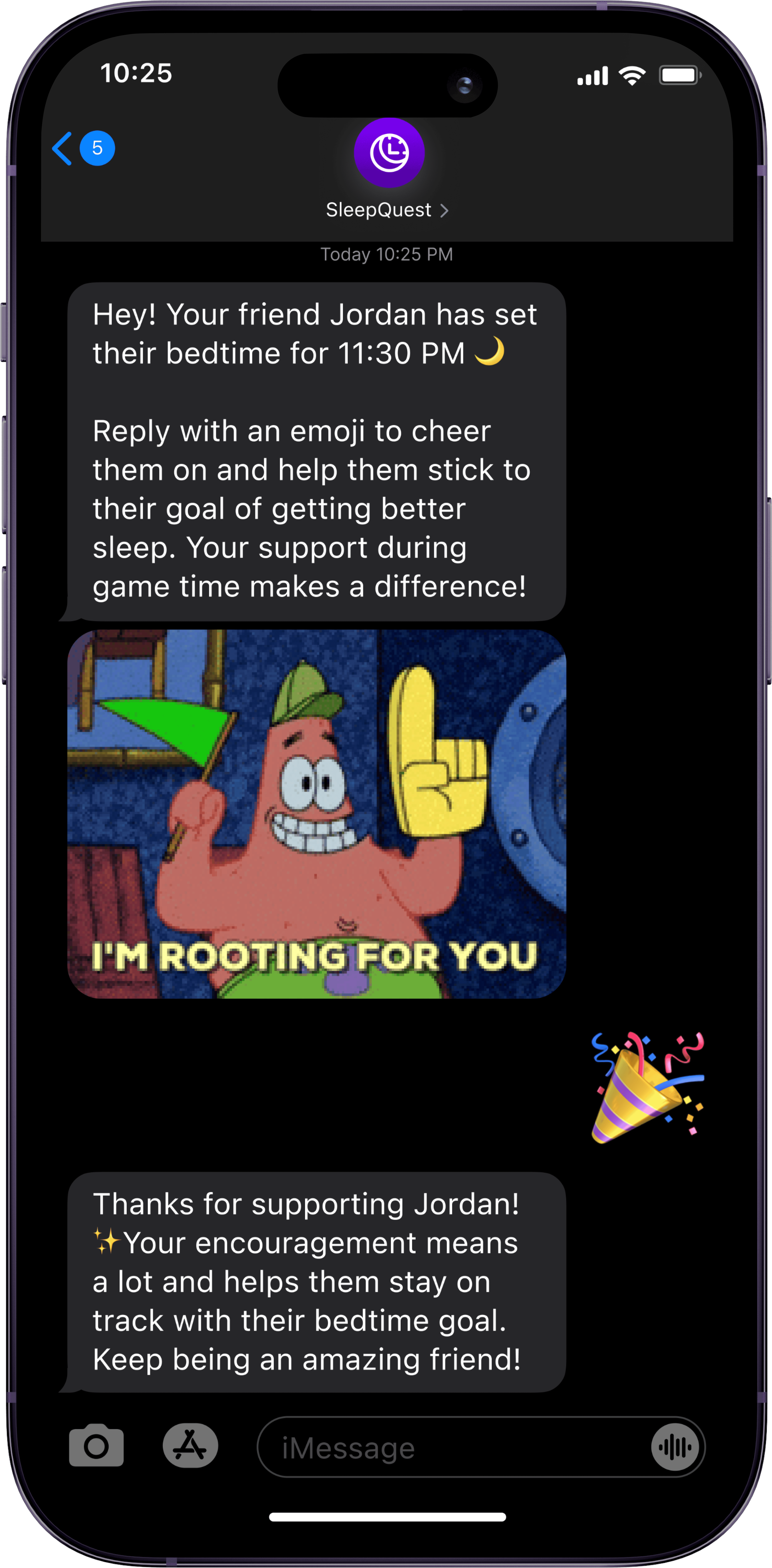





Smartwatch Integration
The smartwatch plays a vital role in the system by capturing accurate sleep data and delivering both visual and haptic feedback for bedtime reminders, social support notifications, and milestone completions. Acting as a passive companion, it enables continuous support without requiring users to pick up their phone or interrupt gameplay.
Smartwatch Integration
The smartwatch plays a vital role in the system by capturing accurate sleep data and delivering both visual and haptic feedback for bedtime reminders, social support notifications, and milestone completions. Acting as a passive companion, it enables continuous support without requiring users to pick up their phone or interrupt gameplay.
Smartwatch Integration
The smartwatch plays a vital role in the system by capturing accurate sleep data and delivering both visual and haptic feedback for bedtime reminders, social support notifications, and milestone completions. Acting as a passive companion, it enables continuous support without requiring users to pick up their phone or interrupt gameplay.
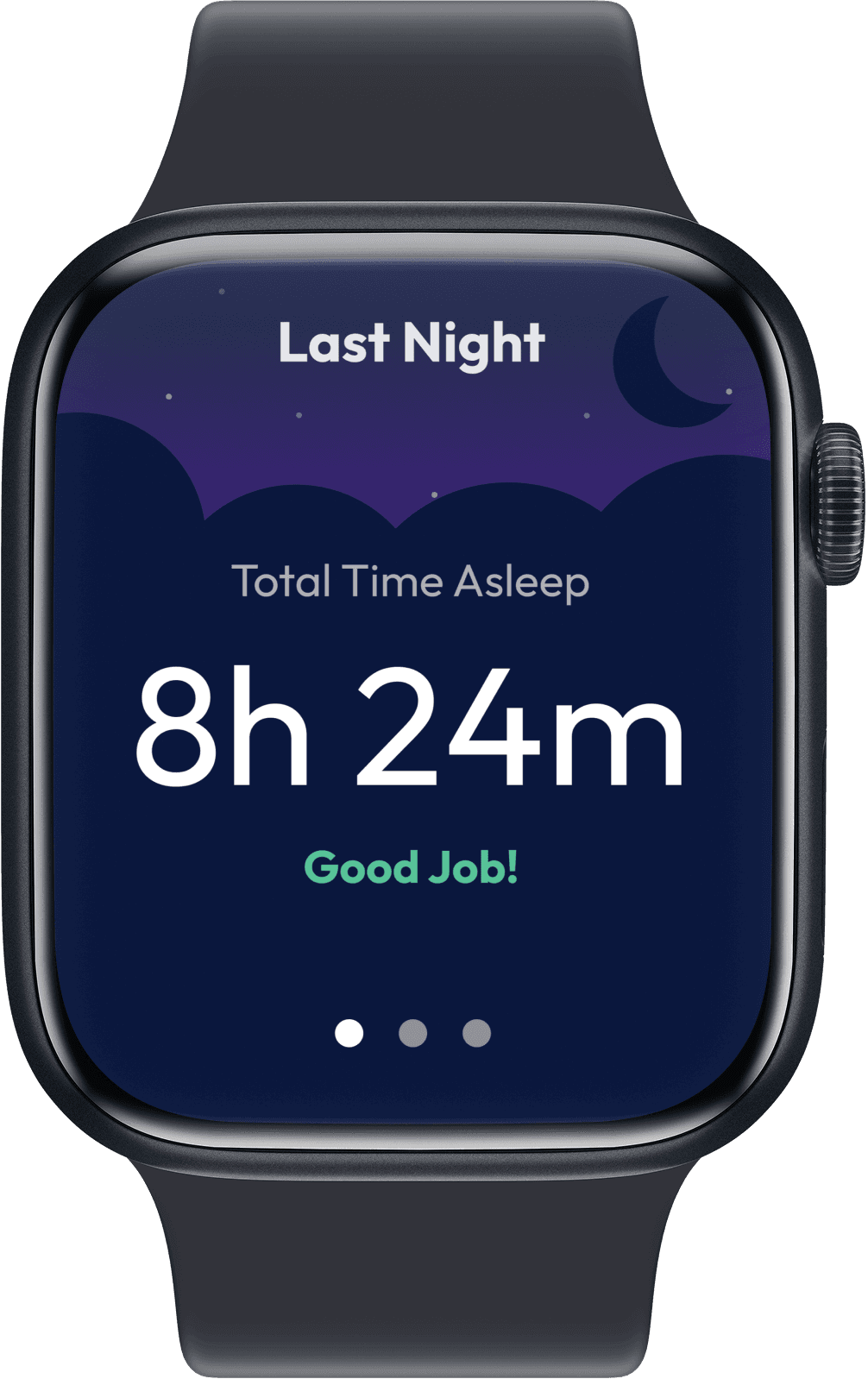


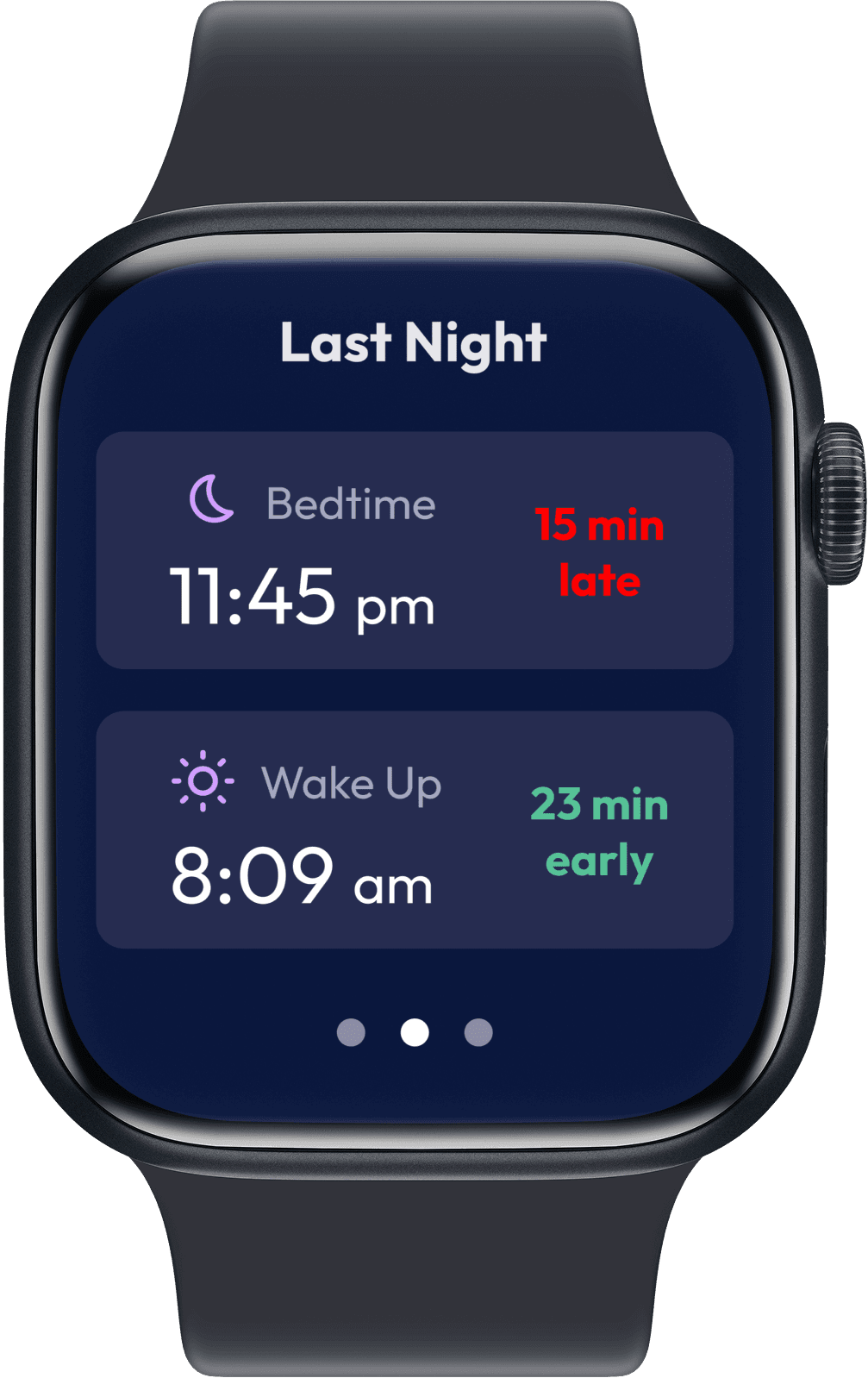


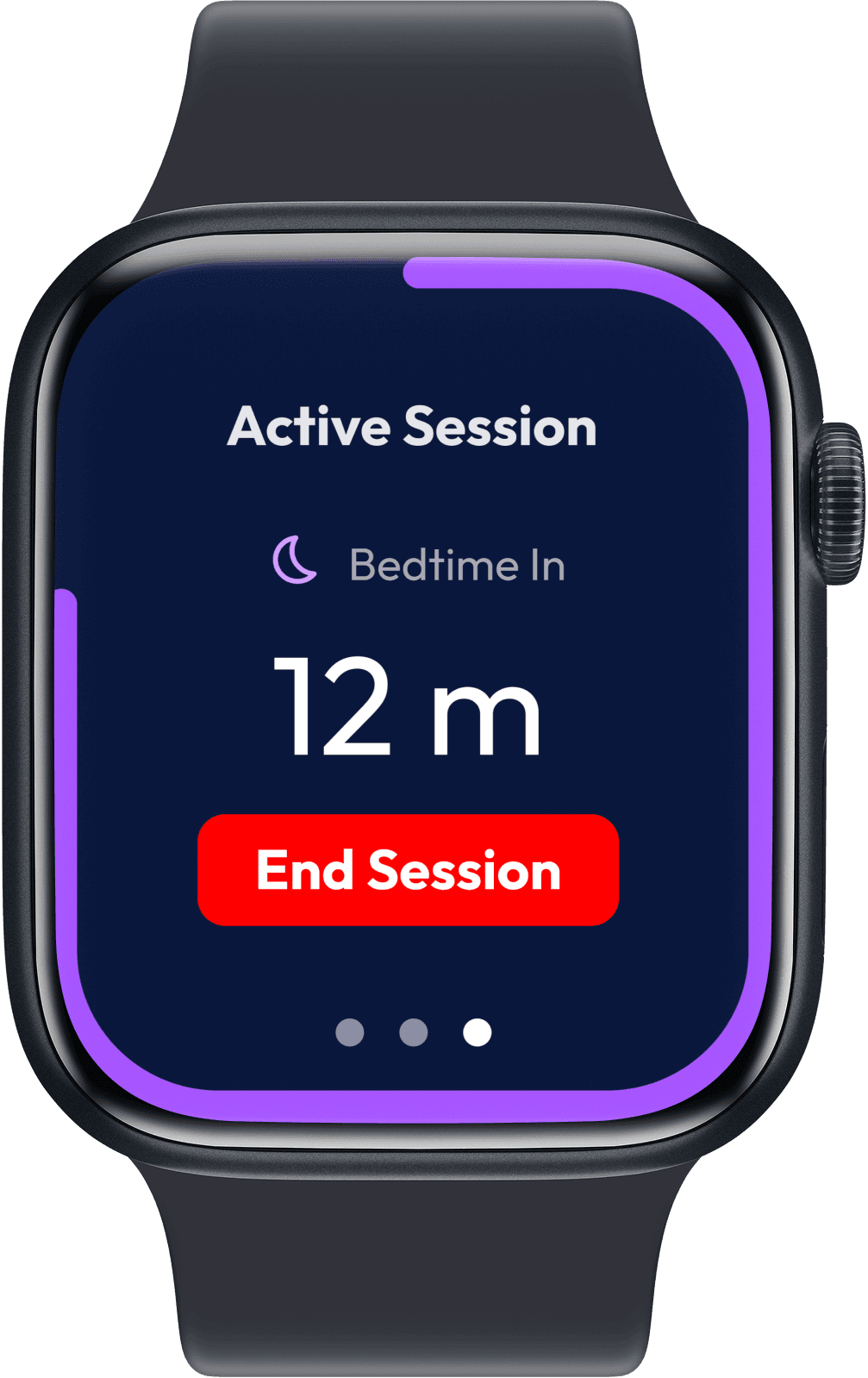


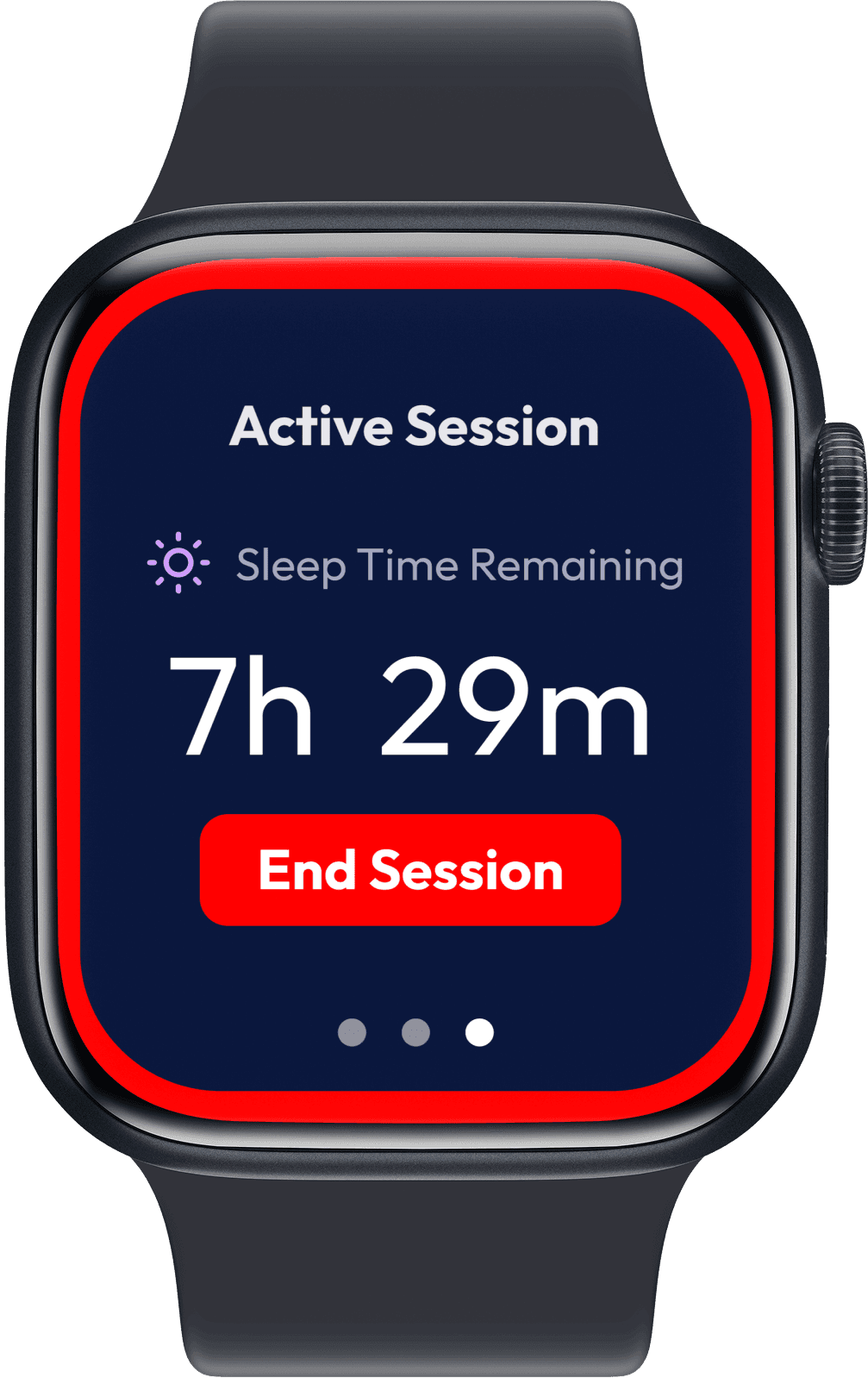


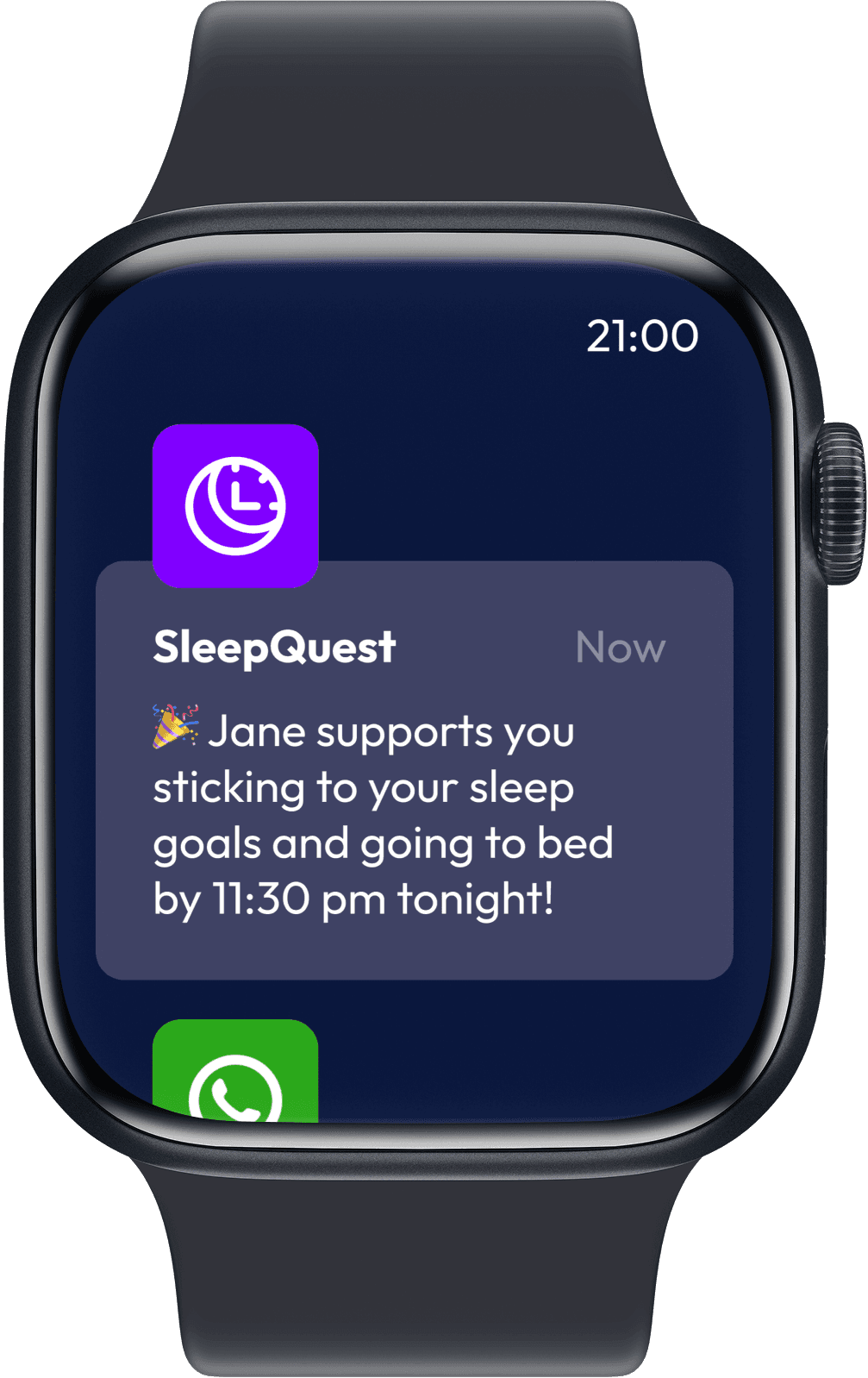


Reflections
Disrupting habits with social insight.
This project challenged me to think critically about designing for behavior change in a space where habits, enjoyment, and social connection collide.
Reflections
Disrupting habits with social insight.
This project challenged me to think critically about designing for behavior change in a space where habits, enjoyment, and social connection collide.
Reflections
Disrupting habits with social insight.
This project challenged me to think critically about designing for behavior change in a space where habits, enjoyment, and social connection collide.
Pre-Set Commitments — Leveraging the Implementation Intentions Theory, forming “if-then” plans to achieve a goal by bridging the gap between having an intention to act and actually performing the behavior.
Pre-Set Commitments — Leveraging the Implementation Intentions Theory, forming “if-then” plans to achieve a goal by bridging the gap between having an intention to act and actually performing the behavior.
Pre-Set Commitments — Leveraging the Implementation Intentions Theory, forming “if-then” plans to achieve a goal by bridging the gap between having an intention to act and actually performing the behavior.
Active Gaming Sessions — Drawing from Self-Determination Theory, giving users control over barrier strength, when they activated a session, and if they chose to follow their bedtime fostered an important sense of autonomy.
Active Gaming Sessions — Drawing from Self-Determination Theory, giving users control over barrier strength, when they activated a session, and if they chose to follow their bedtime fostered an important sense of autonomy.
Active Gaming Sessions — Drawing from Self-Determination Theory, giving users control over barrier strength, when they activated a session, and if they chose to follow their bedtime fostered an important sense of autonomy.
Social Support — Designing for social accountability proved to be one of the most challenging aspects, but involving peers outside the gaming environment emerged as an effective way to offer support without relying on the entire gaming group to use the app.
Social Support — Designing for social accountability proved to be one of the most challenging aspects, but involving peers outside the gaming environment emerged as an effective way to offer support without relying on the entire gaming group to use the app.
Social Support — Designing for social accountability proved to be one of the most challenging aspects, but involving peers outside the gaming environment emerged as an effective way to offer support without relying on the entire gaming group to use the app.
In-Game Barriers — Behavioral nudges created just enough friction to prompt reflection without forcing users to disengage—reinforcing that effective behavior change design isn’t about pushing harder, but about surfacing the right cue at the right time.
In-Game Barriers — Behavioral nudges created just enough friction to prompt reflection without forcing users to disengage—reinforcing that effective behavior change design isn’t about pushing harder, but about surfacing the right cue at the right time.
In-Game Barriers — Behavioral nudges created just enough friction to prompt reflection without forcing users to disengage—reinforcing that effective behavior change design isn’t about pushing harder, but about surfacing the right cue at the right time.
